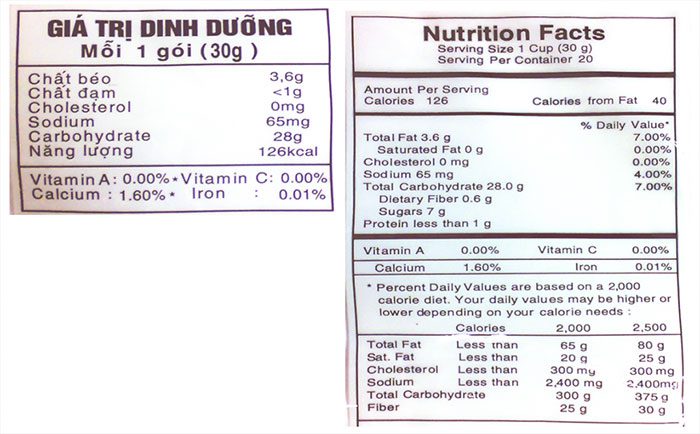If you’ve ever wanted to know exactly what’s in your packaged food, you may be familiar with the black and white nutrition chart on food labels. This chart provides data on calories, protein, fat, and other nutrients. But have you ever wondered how these numbers are measured?
Food is classified into three main macronutrients: protein, fat, and carbohydrates. These are the essential components that the body needs, and each is measured in specific ways.

Nutritional composition chart on packaging.
Protein is measured based on nitrogen content, since protein contains nitrogen, while other nutrients do not. From the nitrogen content, we multiply by a factor of 6.25 (as protein typically contains about 16% nitrogen) to determine the protein content. The two main methods for measuring nitrogen are the Kjeldahl method and the Dumas method, with the Kjeldahl method relying on analyzing the amount of ammonia released from the food sample.
Fat is determined by its solubility in organic solvents such as ether or chloroform. The weight difference of the food sample before and after treatment with this solvent indicates the amount of fat.
However, this method is time-consuming and can be inaccurate, which is why more advanced techniques such as nuclear magnetic resonance and ultrasound are gradually becoming alternatives, despite being more expensive.
Carbohydrates are the body’s primary energy source – usually measured indirectly by subtracting the weight of other components such as protein, fat, water, ash, and alcohol from the total weight of the food.
Finally, to calculate calories, a traditional method is to use a bomb calorimeter, where food is burned, and the change in water temperature indicates the calorie content. However, this method is now less commonly used due to high costs and potential inaccuracies. Instead, the Atwater system is preferred, calculating calories based on the energy content of each nutrient.
Many people wonder if we can trust manufacturers not to exaggerate the nutritional content of their products.
There is not much scientific evidence on this, but today we have more accurate methods for calculating nutritional components, as well as convenient online databases and nutritional analysis services to help consumers feel more assured.





















































